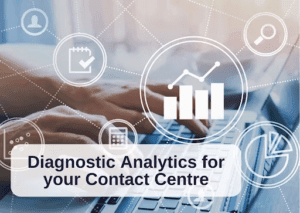The ultimate guide to understanding how Diagnostic Analytics helps you determine the best course of action for lasting results.
Ever felt like you just have too many (or sometimes too few) options available to take and don’t know which is the right one? How about the fact that you have already exhausted four out of the ten options available but you are nowhere near the result you were after? You think surely, I thought I had it right this time. Surely, I knew that all agents should be trained on x, y, z …problem solved! Yet you are coming up empty-handed and now even more worried that the next step is going to be yet another step in the wrong direction.
A policeman sees a man searching for something under a streetlight and asks what the man has lost. The man says he lost his keys and they both look under the streetlight together. After a few minutes, the policeman asks if he is sure he lost them here, and the man replies, no, and that he lost them in the park. The policeman asks why he is searching here, and the man replies, “this is where the light is”.

Isn’t it funny sometimes how we are so limited in choices to really understand where to search for the best answers and actions to it?
Diagnostic analytics is one of the four primary subtypes or categories of types of analytics. Many organisations can benefit greatly from this kind of analytics as well as the other three kinds of analytics, being that of descriptive, predictive, and prescriptive analytics.
Root cause analysis in its most basic form is a discipline of analysis that supports diagnostic analytics. Root cause analysis supports analysts in figuring out why a specific change or event occurred in the data. Therefore, diagnostic analytics is exactly what is required if the objective is to pinpoint the underlying causes of issues in a business and contact centre operations to determine why they developed.
Why Diagnostic Analytics is a great fit for decision making?
Finding the causes and events that resulted in prior occurrences and states is the core goal of diagnostic analytics. In the past it was only data analysts doing diagnostic analytics by delving deeply into the data to find patterns, trends, and hidden relationships between variables, frequently consulting both internal and external sources to obtain the knowledge they require. Lately, the availability of diagnostic analytics platforms has even helped contact centre team leaders and managers do this daily.
It’s interesting to note that although the back-end reporting from a diagnostic analytics technology can be automated the most effective diagnostic analytics knowledge mining process is still carried out manually. It is a human-led, human-in-the-loop process for capturing the interaction intelligence against preconfigured parameters and performance metrics. A human-led approach is still needed to find, validate, and connect the context within which the findings present themselves. Automation on the other hand, like speech analytics, is great for finding high-level patterns. It is however only through the deep cognitive abilities of interaction intelligence analysts that the biggest opportunities and value are found in doing diagnostic analytics.
To perform relevant and accurate diagnostic analytics, deeper root cause analysis is done together with the corroboration of various other data sources to validate the context and understand at a deeper level why something is happening. The primary data sources are often any qualitative data such as recorded voice calls, emails, texts, and chats. The secondary data sources that can support deeper context are to evaluate these interactions against any additional actions taken by the agent (on a CRM system, ERP System or any other workflow and notes captured).
This kind of analytics enables business and operational executives to draw out crucial information from their data and turn it into understandable, and more importantly, visual representations of the insights and actionable intelligence that anybody can use.
Benefits of having ongoing diagnostic analytics in your contact centre:
Companies are becoming more and more dependent on data. Diagnostic tools will assist key decision-makers in making the most of their complex data by transforming it into actionable assets.
By asking the right questions and thoroughly examining the answers, diagnostic analytics enables decision-makers to gain value from their data. A flexible, agile, and adaptable BI and deep analytics platform are therefore required. This then enables decision-makers with actionable insights that are customised to the specific problems and opportunities facing their business.
A business and its contact centre may be better able to replicate its success and handle any problems if it has a deeper understanding of how its business is performing. Businesses can better understand the internal and external factors affecting their results by using diagnostic analytics, uncovering the often hard-to-find things you don’t yet know about your business and contact centre operations.
Organisations can make better judgments thanks to the more comprehensive picture it presents of each situation. Great diagnostic analytics platforms can show managers the deep DNA of successful and unsuccessful client interactions, whether it is within Sales, Services, Collections or Retention.
Three Diagnostic Analytics Applications
There are typically three main applications and uses of Diagnostic Analytics:
Identify anomalies
Discovery
Relationships between causes and effects
If the reason for trends or anomalies revealed by descriptive analysis is not immediately apparent, diagnostic analytics may be necessary. Additionally, if there is a lot of inherent variability in the data, it can occasionally be challenging to tell whether the results of the descriptive analysis reveal a new trend. In those circumstances, diagnostic analytics can greatly help to figure out the underlying root causes.
Data discovery is another use and application, which entails doing diagnostic analytics on various qualitative (voice & text) data to explain the anomalies. This can entail digging into internal customer interaction data as well as collecting external survey data. For instance, a search of external data could turn up changes in supply chains, new rules, or a changing marketplace that is related to the aberrant data.
Further research and application of diagnostic analytics can shed light on whether the associations in the data point to the actual source of the anomaly. This source could be agent-related or even non-agent-related. An advanced technology platform should be able to readily show what root causes are within the agents’ control and which are not.
Any company’s analytics portfolio should include diagnostic analytics as a key component. The ability to do ongoing deep root-cause analysis empowers operations and management with interaction intelligence to change their business and adapt to client needs with more agility. By assisting businesses in understanding why trends and abnormalities arose, the analysis goes beyond merely highlighting them. Diagnostic analytics enables businesses to take more informed decisions to address issues and boost performance by supplying crucial insights into root causes.

Turn on the lights! Shine torch in certain areas, where you can know for sure what you are about to do is taking you closer to the results. Diagnostic analytics are key to unlocking massive value within your company.
Reach out the Genii today to show you how our clients have used diagnostic analytics to empower them with the ability to take the right actions, take better actions, and transform their operations & business KPIs, as well as their customer’s experience, in as little as 4-6 weeks.





